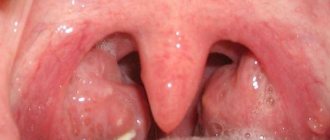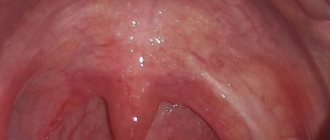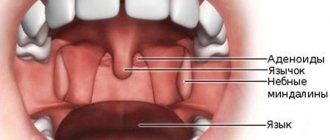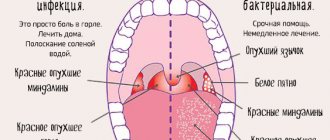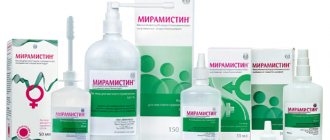Causes of pain in the tonsils
Why do tonsils hurt? There may be several reasons; they may be due to diseases or exposure to external factors. The most common cause of sore throat is infections caused by various pathogens.
The most common causes of pain in the tonsils
- Angina,
- Chronic tonsillitis,
- Pharyngitis,
- Abscess.
Other diseases
- Measles, Chickenpox,
- Scarlet fever.
A situation may also arise in which the tonsils hurt and it is painful to swallow when chlamydia, streptococci or gonococci are present in the body, which have entered through the oral cavity or by airborne droplets.
The causative agents of diseases can be a variety of microorganisms. Most often these are viruses and bacteria. Bacterial infections are more severe and are accompanied by more severe symptoms.
When pathogenic microflora penetrates the palatine tonsils, they react with swelling, a local increase in temperature, and an inflammatory process, as a result of which the body tries to destroy the infection. In this condition, the tonsils become painful.
HIV infection is often accompanied by pain in the throat and tonsils. It is caused by the addition of infections such as cytomegalovrus and candidal stomatitis. HIV leads to a significant decrease in immunity, and is therefore accompanied by frequent throat diseases.
Other causes of pain
- Allergy,
- Irritation from dry air or harmful substances,
- Injury to the mucous membrane of the tonsils.
With allergic reactions to dust, animal hair and other irritants, nonspecific inflammation in the tonsils may occur. They become inflamed and may become painful. This is also a manifestation of the body’s defensive reaction, which tries to protect itself from deeper penetration of dangerous substances. Dry air and volatile harmful substances irritate the throat, which can also cause pain in the tonsils.
Injury to the mucous membrane of the throat and tonsils often occurs when eating solid food; fish bones quite often get stuck in the throat, injuring the tonsils.
Injury is possible when trying to swallow an inedible object. This happens more often with children. As a result of abrasions or scratches on the tonsils, pain may occur; in addition, the injured area is at risk of developing inflammation, which leads to increased pain.
It is quite possible that the tonsil hurts on one side. This means that the inflammation or damage has not completely spread. In diseases, most often, the inflammatory process soon goes further and affects the second tonsil. If, with damage, for example, the right tonsil hurts, it means that the damage is on this side.
When the pathological process begins, it is easy to understand how the tonsils hurt; the symptoms will be typical:
- feeling of tightness in the throat,
- difficulty swallowing,
- pain when swallowing,
- There may be a constant feeling of sore throat.
Causes of inflammation
What infections lead to organ pathology? There are several diseases that lead to swelling of the tonsils. All of them are associated with the action of certain microorganisms.
Angina
This disease is caused by bacteria. Sore throat is characterized by all the signs of intoxication of the body:
- the temperature rises;
- feeling unwell;
- headache;
- tonsils swell;
- There is an increase in cervical lymph nodes.
At elevated temperatures, painful sensations in the muscles and joints, as well as heart spasms, may occur.
Chronic tonsillitis
Frequent sore throats lead to chronic tonsillitis. Systematic diseases weaken the functions of the organ and contribute to swelling and chronic inflammation. Other factors can lead to chronic tonsillitis:
- untreated sore throat;
- weak immunity;
- pathologies of the structure of the nasopharynx.
The disease lasts a long time. Exacerbations are replaced by remission. The period of exacerbation has all the signs of a sore throat: the tonsils are swollen, and the head and throat hurt. During the period between exacerbations, there is a feeling of dryness and soreness in the throat. Joint pain and heart spasms appear periodically. With this diagnosis, the patient faces long-term treatment with an ENT specialist.
Pharyngitis
Pharyngitis is inflammation, swelling of the mucous membrane of the pharynx. The cause of swelling is cold or polluted air. At the same time, we should not forget about the effects of toxic substances that irritate the throat. Inflammation of the tonsils is caused by various microorganisms. Symptoms of pharyngitis are:
- heat;
- muscle pain;
- dry cough;
- weakness;
- mild pain and discomfort in the throat.
We recommend further reading How to quickly relieve swelling of the throat, symptoms and treatment methods.
With pharyngitis, the tonsils become moderately swollen.
Peritonsillar abscess
This pathology occurs as a complication of tonsillitis. It appears abruptly after treatment of the underlying disease. The patient's temperature rises, the tonsils swell, and pus accumulates in the peritonsillar retina. An abscess can be easily distinguished from other pathologies. He is accompanied by bad breath.
Other reasons
Swelling of the tonsils occurs not only due to the penetration of pathogenic microflora. They lead to him:
- allergies;
- tumors in the throat;
- laryngeal injuries;
- very dry air in the room.
The exact cause of swollen tonsils can be determined through a visual examination by a doctor and tests.
What to do if your tonsils hurt
So, if your tonsils hurt, what should you do? Of course, it is necessary to eliminate the cause of these pains, that is, to treat the disease and restore the mucous membrane damaged by injury. However, for any cause of sore throat, measures must be taken to reduce the load on its mucous membranes. This will bring some relief and speed up recovery, because the tonsils will not be subject to additional trauma.
Changing your diet and drinking regime
- Refusal of hot food and drinks.
- Refusal of solid, spicy, sour foods,
- For several days, the diet should be based on semi-liquid and pureed dishes.
If you have pain in the tonsils, you need to drink more fluids. These can be herbal teas, compotes, juices, jelly. All drinks should be warm so as not to irritate a sore throat.
It helps to improve well-being and speed up recovery by being in a room with a high level of humidity; it must be well ventilated, and it must have a comfortable temperature.
Gargling
If your tonsils hurt, how to treat them at home? One of the simple, cheap ways to treat a throat is gargling. Practice shows that systematic rinsing helps eliminate pain and promotes a speedy recovery. When rinsing, the effect occurs directly on the source of inflammation. The tonsils are washed and cleansed of aggressive microorganisms. This helps to cope with inflammation faster. To achieve the maximum possible effect, you need to gargle every hour or every half hour. Then the microbes will die very quickly, because their reproduction will slow down greatly. It doesn’t matter whether the left tonsil hurts, the right one or both, rinsing will be effective.
How to gargle
For rinsing, ready-made pharmaceutical preparations are used, from which a solution is prepared; infusions and decoctions of medicinal plants can have a good effect. The simplest thing is to prepare a saline solution for rinsing. To do this, dissolve half a teaspoon in a glass of warm boiled water. To enhance the effect, you can add a drop of iodine tincture to the saline solution.
Gargles
- Rotokan,
- Furacilin,
- Tincture of calendula,
- Propolis tincture,
- Decoctions of chamomile, St. John's wort and calendula.
Treating swollen tonsils at home
A sore throat is a common problem. It is especially relevant in winter. Are your tonsils swollen? There are many ways to treat them at home. It must be remembered that home therapy concerns mild inflammation. This should only be done when the tonsils are swollen and there is no fever. In other cases, a visit to the doctor is required. First you need to disinfect your mouth. There are many ways to destroy pathogenic bacteria.
Rinse
As soon as swelling of the tonsils begins, treatment with antiseptic solutions is used:
- Dissolve a teaspoon of soda in a glass of warm boiled water and rinse the swollen tonsils.
- A furatsilin tablet is mixed with 100 ml of warm water and used to rinse the tonsils.
- Finely chop a clove of garlic and pour a glass of boiling water. Let cool. Infusion to gargle.
Medicinal herbs are used for rinsing: cornflower, chamomile, black elderberry flowers. If the tonsils are swollen due to allergies, then a decoction of nettle or string will help.
Inhalations
If your tonsils hurt, traditional medicine will help. The most effective of them are inhalations:
We recommend that you read additionally: What could it be if a swelling or swelling has formed in the neck area above the collarbone?
- Pour a tablespoon of dried chamomile into a glass of water and put on fire. When the liquid boils, reduce the gas and breathe in the steam through a paper cone.
- Peel the potatoes and cook. At the moment of boiling, reduce the gas, cover your head with a towel and breathe in the steam.
Inhalations will help relieve pain when swallowing, but if the disease is accompanied by high fever, inhalations should not be done until the temperature subsides.
Warming up
Sore throat and don’t know how to treat it? The most beneficial is to warm swollen tonsils with sea salt. Heat dry sea salt in a clean frying pan. Then pour it into a cloth bag. This bag is wrapped in a towel and applied to the sore throat. An alternative to salt is sea stones. If the tonsils swell often, then you should bring it from the sea or find flat granite somewhere. The stone is heated strongly on a gas stove, wrapped in a towel and held on the neck.
If you have a cold, it is good to warm up your whole body. You can steam your feet only when the temperature is not elevated. For steaming, mustard powder is diluted in hot water, the feet are dipped in there and left for half an hour. Then they wipe dry and lie down under a warm blanket.
Steaming your feet stimulates blood circulation throughout the body, which helps activate internal resources to fight infection. This old remedy works not only when the tonsils are swollen, but will also help with any inflammation.
Compresses
Compresses will help cure swollen tonsils. The simplest is an alcohol compress. You should soak cotton wool with alcohol and wrap it around your neck. Place a plastic bag or wax paper over the cotton wool. Cover everything on top with a warm scarf. Apply the compress at night and keep it until the morning. In the morning, the condition of the swollen tonsils will improve.
Fluid intake
What should you do if your tonsils are swollen after a cold and it hurts to swallow? For any infection of the body, it is useful to drink plenty of warm liquid. Lemon juice is added to it. Lemon juice will help kill pathogenic flora. Drinking plenty of fluids helps to quickly remove all excess from the body. Swollen tonsils go away quickly.
Drug treatment
For sore throat, treatment is prescribed in accordance with the reasons that caused it. If it is a viral or bacterial infection, then antiviral or antibacterial drugs are prescribed. Ideally, antibiotics should be selected taking into account the sensitivity of pathogens to them. However, this test requires at least three days to complete, so often if there are clear signs of a bacterial infection, the doctor will prescribe broad-spectrum antibiotics.
Local medications are useful for sore throats. They help cope with inflammation and reduce pain. Such products are available in the form of aerosols, tablets and lozenges for resorption. They act directly on the tonsils, so they give a quick effect.
Remedies for sore throat
If a sore throat occurs, it is best to start treatment as early as possible. Then the results will be better and faster. Before the doctor arrives or before going to the clinic, you can start rinsing and adjust your diet. The rest of the treatment will be prescribed by a specialist, taking into account the causes, characteristics of the disease and possible consequences.
Unpleasant painful sensations can greatly worsen the general condition, disrupting performance and normal sleep. If such discomfort is localized in the throat area, then the person also faces pain when swallowing and appetite disturbances. Quite often, otolaryngologist patients complain of pain in the tonsils. They can be caused by a variety of factors, but regardless of the etiology of such symptoms, they must be dealt with. So, how to behave if your tonsils hurt very badly: how to treat such a symptom? What to do if your tonsils hurt? What to rinse with?
Rinse for pain in the tonsils
As practice shows, systematic rinsing is best suited to eliminate painful sensations in the tonsils. If you carry them out at intervals of half an hour to an hour, the intensity of the pain will decrease very quickly, because this procedure perfectly cleanses the tonsils of aggressive organisms and reduces inflammatory processes.
For rinsing, you can use a variety of medicinal compositions. The use of an ordinary saline solution (you can add a drop of iodine to it), as well as a Furacilin solution, has an excellent effect. In addition, you can prepare a weak solution of propolis or calendula tincture. A good choice would also be various herbal decoctions and infusions, for example, based on the same calendula, chamomile, etc.
Medicines for tonsil pain
To eliminate pain and inflammation in the tonsils, you can use local medications, which can be easily purchased at any pharmacy without a doctor's prescription. An excellent option would be to use aerosols and various lozenges. They have antiseptic, anti-inflammatory, and analgesic effects.
For pain in the tonsils, a good treatment option would be to use the Gammidin-Neo resorption agent with an anesthetic. This medication is an antibacterial compound and has a good analgesic effect.
Stopangin 2A, which is a source of local antibiotic and anesthetic, may also be the drug of choice. A certain amount of analgesic component is also present in Anti-Angin Formula, Septolete Plus, Strepsils Plus, Theraflu LAR, Hexoral Tabs, etc. In addition, Tantum Verde, Falimint and Cameton can be used to eliminate pain in the tonsils.
All of these drugs have certain contraindications and can cause various side effects. To select the most suitable composition, you should seek doctor’s help.
Tips for tonsil pain
To eliminate pain in the tonsils, it is extremely important to slightly change your usual diet and drinking regimen. First of all, until the unpleasant symptoms stop, you should completely avoid hot food and drink, and you should also avoid consuming mechanically aggressive foods that can irritate inflamed mucous membranes and aggravate the clinical picture. Ideally, you need to switch to eating only liquid, pureed and slimy foods for at least a few days. You should not eat spicy, sour and peppery foods, or indulge in pickles and carbonated drinks.
As for the drinking regime, all experts strongly recommend drinking more warm liquid for pain in the tonsils. These can be a variety of teas, including herbal teas, milk, compotes, etc.
Among other things, if pain occurs in the tonsils, you must be in a fairly cool, ventilated room with a high level of humidity. Only this measure can speed up the recovery process by an order of magnitude and improve the general condition of the patient.
Traditional medicine for tonsil pain
If pain occurs in the tonsils, traditional medicine experts advise chewing a small piece of natural high-quality propolis for a long time. This beekeeping product is a real storehouse of useful substances; it effectively eliminates inflammatory processes, destroys a variety of aggressive particles and has some analgesic effect.
Also, taking warm homemade milk with high-quality honey has a good effect on sore throat. You can also add fat to this drink, for example goat fat, or butter. Drink it in small sips several times a day.
Beetroot juice can be a good option for rinsing for pain in the tonsils. In a glass of such liquid you need to dissolve a tablespoon of table vinegar. Rinse with this mixture up to five times a day.
Take aloe leaves, wash them and dry them. Cut these raw materials into small pieces and place them in a half-liter container so that it is filled halfway. Sprinkle the prepared leaves with regular granulated sugar. This product must be infused for three days, after which the container should be filled to the top with vodka. Tie the neck of the jar with gauze and leave the medicine to infuse again for three days. After this, the resulting composition must be filtered, and the plant material must be squeezed out. This liqueur can be stored in the refrigerator for quite a long time. It should be consumed one tablespoon immediately before meals three times a day. Of course, you don’t need to be treated with cold medicine.
If you experience pain in the tonsils, consult a doctor; this symptom can be caused by a variety of pathological conditions.
This is a common accompaniment of many colds, and the attitude towards it is not always responsible. Therefore, everyone should know how to distinguish mild pharyngitis from a severe sore throat and protect themselves from complications.
We need to start with a little clarification of terms. Tonsils and tonsils are synonyms. It’s just that tonsils are a derivative of the Latin name, and tonsils are a translation from Greek. Therefore, when they say “the tonsils hurt” or “the tonsils are enlarged”, we are talking about the same organ, namely the glands of the lymphadenoid apparatus of the nasopharynx - a powerful immune outpost of the body.
How to treat tonsil diseases?
First, you need to figure out why the tonsil may become inflamed on one side. It is best to consult a doctor. The otolaryngologist will examine the patient, prescribe additional examinations, if necessary, and select treatment.
Quite often, swollen tonsils or an inflamed tonsil on one side are only a complication of another disease. Gargling or washing the tonsils in this case will only have a temporary effect if the cause of the disease is not eliminated.
READ ALSO: Wen on the body: who to contact, which doctor treats
Gargling
How to treat a throat if the tonsil hurts on one side - it depends on the accompanying symptoms. It is recommended to start by rinsing with antiseptic agents. If the cause is a bacterial infection of the tonsils, rinsing will help eliminate pathogenic bacteria, and thereby reduce pain and swelling. In cases where pain is associated with injury to the tonsil, rinsing will reduce the risk of secondary infection and speed up the recovery of damaged tissue. For treatment, you can use both pharmaceutical and folk remedies.
- Sea salt. The simplest and most affordable remedy that you can probably find at home, or at least in the nearest supermarket. Salt rinses are recommended for moderate pain, including tonsil injuries. To prepare the solution, dissolve a teaspoon of the product in a glass of water.
- Soda with salt. Another simple remedy, the so-called first aid for a sore throat. To prepare the solution, mix a teaspoon of baking soda and salt in a glass of water. The water should be at a comfortable temperature, about 37 degrees.
- Iodine solution. This remedy has proven itself excellent for stomatitis on the tonsils and tonsillitis. To prepare the solution, mix 5 drops of iodine in a glass of water and gargle thoroughly.
- Chlorophyllipt. Another effective gargle. Used for tonsillitis and pharyngitis. The product is concentrated, diluted with water in proportions of 1 to 5.
- Among folk remedies, you should pay attention to decoctions of chamomile, sage, and calendula. To prepare the solution, pour 1 large spoon of dried raw material into 500 ml of water and cook for 15 minutes. Then cool and use to gargle.
If the tonsil hurts on one side, treatment should be comprehensive. So, you need to gargle at least three times a day. Additionally, you can use various lollipops for tonsillitis and pharyngitis. Unilateral tonsillitis, or inflammation of the tonsil on one side, is treated with Strepsils, Septefril, Hexoral.
To prevent the gland, which is inflamed due to injury, from becoming infected, you can lubricate the damaged area with Lugol's solution.
Compresses
It is strictly not recommended to apply compresses to the throat at very high temperatures.
Compresses help bring down the temperature, but are generally useless for the throat. If your body temperature has risen to 38 degrees, you can put a cool compress on your forehead. At temperatures above 39 degrees, vodka compresses and rubbing are effective.
Traditional medicine suggests placing compresses directly on the neck. However, this method has many contraindications:
- purulent inflammation of the tonsils,
- heat,
- enlargement or inflammation of the cervical lymph nodes.
To reduce pain when swallowing, make compresses from warm crushed potatoes, vinegar solution, and vodka. Such remedies help reduce swelling of the tonsils.
Inhalations
To combat the pain inherent in enlarged tonsils, inhalations can be used. This method has proven itself well in the fight against colds, but is ineffective against tonsillitis or pharyngitis. At the same time, inhalations will prevent a sore throat if one (right or left) tonsil is injured, and also strengthen the immune system and prevent infection.
For inhalation you can use:
- drug Pinosol,
- Chlorophyllipt,
- natural pine essential oil (3 drops per liter of water),
- steam from boiled potatoes.
Inhaling warm steam helps relieve cold symptoms and is effective if sinusitis is the cause of swollen tonsils on one side.
Note! The simplest and most affordable inhaler is the Zvezdochka pencil, containing essential oils of mint, eucalyptus, and camphor. The product can be purchased at any pharmacy at an affordable price.
READ ALSO: Pimples after antibiotics - why they appear on the face after taking medications and how to treat them, review of products
Inhalations are prohibited at high temperatures.
General therapy
If a person has a swollen tonsil on one side, what to do with this symptom will depend on other signs. In the case of a bacterial infection, your doctor may prescribe broad-spectrum antibiotic tablets. Such drugs cannot be taken independently, without a prescription.
For viral diseases, special immunomodulators are prescribed. Immune medications may be recommended for a speedy recovery. As a folk remedy, you can take tincture of echinacea or propolis.
For severe tonsillitis, the doctor may recommend rinsing the lacunae of the tonsils. This procedure is carried out in case of accumulation of purulent masses in the tonsils and the formation of plugs.
Eagle-Sterling syndrome is treated with novocaine blockades, glucocorticosteroids or surgery if conservative therapy is ineffective. In this case, only a doctor selects a treatment regimen; self-medication can be harmful to health.
Detoxification
Rosehip tea helps a lot
In infectious diseases, intoxication of the body is observed. At high temperatures, a person loses a lot of fluid through sweat, and dehydration occurs. Due to the inflammatory process, weakness and nausea are observed. In such cases, detoxification therapy is necessary. It is carried out either with special mineral-containing solutions (Regidron, Regidron Bio), or by increasing the consumption of pure liquid.
Decoctions of medicinal herbs with a diuretic effect will also come to the rescue. Traditional medicine advises drinking a rosehip decoction, which not only removes toxins, but also strengthens the immune system due to its high vitamin C content. Herbal teas (chamomile, mint, lemon balm) and a decoction of lingonberry leaves are also useful.
Drinking plenty of fluids when sick
If a tonsil that is swollen on one side is the result of a bacterial infection, for example, with tonsillitis, you must follow several recommendations regarding drinking regime and diet. Doctors recommend increasing the amount of fluid you drink to speed up recovery. Recommended to drink:
- clean water at a comfortable temperature,
- herbal teas,
- fruit drinks and compotes,
- warm milk with honey.
Milk reduces discomfort in the throat and eliminates the sore throat characteristic of pharyngitis. It is recommended to drink at least two liters of clean water per day. It is better to drink half a glass every 20-40 minutes.
Having figured out what to do if the tonsil is swollen on one side, you should pay attention to nutrition. It is necessary to remove from the diet any solid food that can irritate the tonsils. It is recommended to increase the consumption of fruits and vegetables, it is better to puree them or drink freshly squeezed juices.
Any food should be at a comfortable temperature; food that is too hot or too cold should be avoided.
Etiology (causes)
The range of reasons why a sore throat can hurt is very limited. This may be mechanical or thermal tissue damage, infection, allergic reaction or neoplasm. The presence or absence of the following signs will help determine the direction of further therapy:
- Has your throat been injured recently, including consuming very hot food or drinks?
- Have you had any infectious respiratory diseases, such as ARVI, in the last two weeks?
- Does the patient suffer from local chronic infection: caries, periodontitis, chronic tonsillitis, sinusitis?
- Does the person suffer from common infectious diseases, for example, tuberculosis, HIV, syphilis?
- There have been previous cases of allergic reactions, including soreness or pain when swallowing
Having gained an idea of the source of the problem, you next need to move on to the most important part of the investigation into why tonsils hurt - examining the oral cavity.
The tonsils are located in a niche located in the thickness of the soft palate. Depending on the individual anatomical features of the oral cavity, the tonsils can either protrude outward and be clearly visible, or be completely hidden in the palatal recess. This determines whether it will be easy to find them during inspection. In any case, in order to facilitate the examination and avoid the urge to vomit, follow the step-by-step instructions given below.
Preparing the site and tools
Before starting any examination, especially those related to mucous membranes, you must choose a lighted place, prepare a mirror and wash your hands with soap.
Since the tonsils are located deep, you will most likely have to use additional lighting in the form of a table lamp or flashlight.
You will also need a medical spatula or its substitute. Of course, it is more convenient to work with a spatula - its flat and rounded shape allows you to open the view of the oropharynx as safely as possible. However, a tablespoon with a flat, rounded handle without sharp corners will also work.
The instrument, whether it is a spatula or a spoon, must be washed with soap and treated with an antiseptic, for example, chlorhexidine or hydrogen peroxide, both before and after the examination, in order to avoid the spread of infection to others.
Performing an inspection
To examine the pharynx and oral cavity, the subject needs to open his mouth as wide as possible, but without sticking out his tongue. Next, you need to insert a spatula into the oral cavity and, with its entire plane, press the front 2/3 of the tongue down and slightly forward. Compliance with these requirements will avoid the gag reflex.
During examination, the patient must pronounce the sound “a”, during which the soft palate rises and the upper part of the posterior wall of the pharynx becomes visible. At this point, you need to pay attention to the following signs:
- Color of mucous membranes
- The presence of tubercles (lymphoadenoid granules) on the posterior wall
- Size, color, density of palatine tonsils
- The presence of whitish plugs in the body of the tonsil
- The presence of films, rashes on the tonsils or mucous membranes of the pharynx
Examination of the tonsils and oral cavity will allow you to make a final conclusion about why the tonsils hurt: due to infection, injury or allergies.
Important! It is worthwhile to examine a healthy oral cavity once, during a period when nothing is bothering you. This will help determine the normal individual color and size of the tonsils, uvula and arches of the soft palate, as well as the healthy color of the larynx and pharynx. Then later it will be much easier to identify redness and changes in shape and size caused by the disease.
Infectious diseases
Infectious diseases of the pharynx are primary - when the source of infection is in the pharynx itself and is the cause of pain in the tonsils, and secondary - when soreness in the pharynx is only a manifestation of the underlying infectious disease.
However, it is more important to divide a sore throat according to another criterion: cases when you can get rid of it on your own and when you need to urgently go to the doctor.
The first include only one disease, but the most common is acute pharyngitis. The second is a whole series of serious diseases from vulgar tonsillitis to an abscess, curable only in a hospital.
What can be treated at home
Pharyngitis is an acute inflammation of the pharyngeal mucosa. Its causes can be viruses, bacteria and chlamydia.
Predisposing factors also have an important influence. Hypothermia, smoking, and drinking alcohol cause irritation of the throat mucosa and decreased immunity. Nasal diseases increase the risk of infection spreading to the throat.
The main symptoms of pharyngitis:
- Constantly itchy and sore throat
- Sore throat that gets worse when swallowing
- Sometimes a slight increase in temperature
- Possible headache
Treatment of pharyngitis is carried out by rinsing the mountain with antimicrobial solutions and using antiseptic medications: sprays or lozenges for resorption.
When is it time to go to the doctor?
You should consult a therapist for help if the tonsils are involved in the inflammation process and the following signs are detected:
- Tonsils are bright red
- Tonsils hurt a lot
- Pain is felt when pressing on the tonsil
- Tonsils are swollen
- Visible white inclusions, films or pus on the surface of the tonsil
- The temperature has risen
All these signs indicate a serious inflammatory process that requires antibacterial therapy, which can only be prescribed by a doctor after testing the patient for the sensitivity of the pathogen to various types of antibiotics.
Important! Self-use of antibiotics without testing the sensitivity of the pathogen to them can lead to complications of the disease.
Primary infectious lesions of the tonsils
Primary infectious lesions of the tonsils include tonsillitis. Another name for diseases of this group is tonsillitis.
There are several types of sore throats, differing in appearance and symptoms. Detailed classification is given in the table.
The tonsils (tonsils) play an important role in maintaining human health. More than 70% of microbes and viruses that penetrate the body along with air and food are deposited on the tonsils. It is the tonsils that take the first blow when infection penetrates. And if a person’s immunity is weakened, the tonsils become inflamed and swollen.
The main causes of inflammation of the tonsils
Most often, swollen tonsils indicate the development of an infection in the body. The patient may complain of soreness, a feeling of squeezing, cutting and throbbing pain in the throat. Symptoms of the disease can be expressed in different ways:
- acute pain in the throat on one or both sides;
- pain when swallowing food or saliva;
- swelling of the glands;
- headache;
- Possible loss of voice or hoarseness.
A specialist will be able to determine the underlying disease based on these symptoms. The most common diagnoses accompanied by swelling of the tonsils include:
Despite the similar symptoms at the initial stage of the disease, each disease has its own distinctive features.
Sore throat (acute tonsillitis) refers to infectious and allergic diseases.
The disease is provoked by bacteria and fungal organisms: yeast-like fungi Candida, streptococci, staphylococci, etc. The virus is localized in the throat, and the patient may complain of acute and unbearable pain when swallowing. Acute tonsillitis can be distinguished from acute respiratory infections by a rapid increase and maintenance of body temperature within 39°C. It becomes painful for the sick person to eat, drink and even talk.
Among the main symptoms of acute tonsillitis are:
- chills;
- aching joints;
- temperature increase up to 40°C;
- severe sore throat;
- tonsils swell and increase in size;
- New growths may appear on the tonsils - white spots or plaque on the tonsils;
- enlarged lymph nodes.
Children and adolescents are more often susceptible to sore throat, especially during the cold season. Adults can also get sick, but much less frequently. In any case, if the tonsils are swollen and the temperature persists, you should consult a doctor. The specialist will determine the form of sore throat, prescribe the necessary tests and timely treatment. If acute tonsillitis is left to chance, serious complications are possible.
As a result of complications of a sore throat, a tonsil abscess can develop - a swelling filled with pus, which is located near the soft palate and interferes with the functioning of the tonsils. The disease is characterized by a sharp increase in body temperature.
Abscesses come in different forms, often called inflammation of the tonsils. In addition to high fever, the disease is accompanied by severe pain when swallowing.
An abscess can be identified by other signs:
- when moving your head, a sore throat occurs;
- there is an unpleasant odor from the mouth;
- symptoms of intoxication are observed;
- jaw muscles cramp,
- swollen tonsils hurt mainly on one side.
Like most other diseases associated with inflammation of the throat, an abscess is dangerous for complications. It is important to seek medical help in time.
Chronic tonsillitis
The disease does not make itself felt until a certain time. Usually develops after a sore throat or other infectious diseases. The throat may hurt for a long time and painfully, but there will be no increase in temperature. The tonsils become a source of constant infection, the symptoms of the disease clearly manifest themselves during periods of relapse.
Typically, chronic tonsillitis is provoked by the following factors:
- sore throat that has not been cured;
- dental caries;
- sinusitis;
- purulent sinusitis;
- polyps;
- adenoids;
- weakened immunity.
During an exacerbation, the patient feels that the tonsils are swollen, dry mouth and discomfort when swallowing appear. A person is in a state of constant fatigue, drowsiness and irritability. Temperature may rise and heart and joint pain may occur.
Chronic pharyngitis
The disease rarely occurs on its own. Develops against the background of a local decrease in immunity of the pharyngeal mucosa. The reason for the development of chronic pharyngitis is the ingress of various viruses. When the body cannot resist pathogenic bacteria, minimal hypothermia is enough for the disease to become chronic.
The first symptom of the disease is a condition where the tonsils are swollen, but do not hurt, and mucus drains down the back wall of the throat.
With chronic pharyngitis, there may be a disturbing sensation of a “lump” in the throat, which causes the need to cough. This cough is usually dry, occurs at night and prevents the patient from sleeping.
Other causes of swollen tonsils
Unpleasant sensations when swallowing occur not only with the development of infectious diseases. This can also happen when a mechanical injury occurs, for example, a person damages the tonsil with a bone from a fish. Other provocateurs include:
- Allergic reactions - the tonsils may swell in people who are allergic to animal fur, pollen, plant sap, or dust.
- Bad habits - when smoking, smoke burns the mucous membrane of the throat, which can result in swelling.
- Dry air has an adverse effect on the mucous membrane of the larynx, dries it out and causes swelling of the glands.
- Toxic substances - all kinds of household chemicals and polluted air - penetrate into the respiratory tract and cause damage to them.
Causes of pain
Drinking cold water with a “weak throat” can cause a sore throat
If the tonsil hurts on only one side, the causes must be sought in diseases of the throat of a viral or bacterial nature. Pain itself is not a disease. This is a symptom that can accompany various pathologies.
In general, an enlarged tonsil on one side is a sign of unilateral inflammation. The tonsils are an organ of the lymphatic system, and therefore react acutely to various pathological processes in the body caused by bacteria. Pain in the throat cannot be ignored, otherwise the disease may become chronic or cause complications. Among the probable reasons why the left or right tonsil hurts:
- tonsillitis (tonsillitis),
- pharyngitis,
- bacterial infection of the tonsils,
- fungal infection,
- Eagle-Sterling syndrome,
- mechanical damage to the lymphoid tissue of the tonsils,
- stomatitis,
- sinusitis,
- otitis.
Each of these conditions has specific signs that may suggest a diagnosis.
Causes and symptoms of tonsillitis
If the tonsil hurts on only one side, you first need to rule out the most likely cause - tonsillitis. In everyday life, the disease is known as sore throat, and is one of the most common throat problems in children and adults.
If the tonsil is swollen on only one side, we are talking about acute unilateral tonsillitis.
- sore throat on one side, worsening when swallowing,
- increase in body temperature to 38 degrees or higher,
- general malaise,
- plaque on the affected tonsil,
- Upon examination, redness and swelling of the tonsils are noticeable.
In most cases, the disease is caused by a bacterial infection, less often by viruses or yeast. The disease develops against a background of weakened immunity, in particular due to hypothermia.
Important! Tonsillitis must be treated promptly, otherwise it becomes chronic. In this case, the disease recurs at the slightest weakening of the immune system.
Another cause of an enlarged right tonsil is chronic sinusitis (sinus disease). In this case, the infection simply spreads to the tonsils, causing pain and inflammation.
Pain in tonsils with pharyngitis
Frosty air in winter can lead to irritation of the larynx and, as a result, its inflammation
Another common disease is pharyngitis. It is an inflammatory process that affects the mucous membrane of the pharynx and the lymphoid tissue of the tonsils. If the tonsil is inflamed on only one side, pharyngitis must be ruled out.
- inhaling too cold or too hot air,
- irritation of the mucous membranes by chemicals,
- complicated infections of the mouth or sinuses,
- advanced caries,
- bacterial infection, fungal infection of the mucous membrane,
- pharynx injuries.
The disease begins with a sore throat and dry mucous membranes. Pain when swallowing occurs several days after the onset of the inflammatory process. Moreover, the pain can also be one-sided, as with tonsillitis, if we are talking about inflammation of the tonsil on one side. However, pain in the tonsils with pharyngitis is a secondary symptom; the primary symptom is redness and swelling of the mucous membrane of the entire pharynx.
READ ALSO: Pimples on the penis: on the head, white, on the skin, photo, red, why, under the head, small, on the shaft, how to get rid
Important! Experienced smokers are at risk for developing pharyngitis. People who are addicted to nicotine are more likely to experience this disease compared to non-smokers.
With pharyngitis, general symptoms are also observed - increased body temperature, drowsiness and malaise, decreased performance. The disease may be accompanied by a small rash around the mouth.
Bacterial infection of the tonsils
Another reason why only the right tonsil hurts may be infection with pyogenic bacteria - staphylococci or streptococci. The infection can be acquired in a variety of ways, most often due to injury.
- rash on face,
- pustules on the mucous membranes of the cheeks and lips,
- inflammation and swelling of the tonsils,
- white or grayish coating on the tonsils.
If the tonsil hurts only on the right side, it is likely that the right mandibular or tonsillar lymph node is enlarged.
Severe acne can also cause infection. In this case, damage to the rash on the face is potentially dangerous due to the entry of pyogenic bacteria into the mouth, and from there to the tonsils and larynx. As a rule, inflammation of the tonsils in this case is caused by a general decrease in immunity.
Eagle-Sterling syndrome
A rather rare pathology, manifested by deformation of the styloid process and changes in the stylohyoid ligament. The right styloid process is longer in each person. With Eagle-Sterling syndrome, its deformation is observed, which entails pain in the right gland and discomfort when swallowing.
Another characteristic symptom of this disease is the ineffectiveness of treatment with conservative methods. To relieve pain, a person can use various gargles, which are ineffective in this case. Patients often complain of a sensation of a foreign body in the larynx.
Tonsil injuries
The throat can be easily scratched by rough food
If the tonsils hurt on only one side, and swelling makes it difficult to swallow, but no other symptoms are observed, the likely cause is mechanical damage to the tonsil. This can happen when chewing too rough food, such as crackers. The tonsils are scratched, a small wound appears, then inflammation develops and swelling appears. In case of decreased immunity, there is a high probability of infection of the resulting wound with bacteria that normally inhabit the oral mucosa.
Stomatitis
Although stomatitis is a disease of the oral cavity, it can also affect the tonsils. A characteristic sign of the disease is small ulcers or wounds on the mucous membrane of the cheeks. The oral cavity swells, the mucous membrane turns red, and severe discomfort is felt when eating. Over time, the infection spreads to the tonsils, and stomatitis can affect either one tonsil or both. In this case, the organ swells, a light coating appears, and pain occurs when swallowing.
You can distinguish stomatitis on the tonsils from tonsillitis by the absence of high temperature and damage not only to the tonsils, but also to the oral mucosa.
Sinusitis and otitis media
Sinusitis is an inflammation of the sinuses, and otitis is an inflammation of the middle ear. Both diseases can be either unilateral or bilateral, and are often complicated by inflammation of the tonsils.
In case of sinusitis, the tonsil on the left side may hurt due to damage to the left sinus. If the left tonsil is inflamed, the culprit is infected phlegm running down the back of the throat and irritating the tonsils. With otitis media, the inflammatory process quickly spreads to other ENT organs, including the tonsils and sinuses, so the disease is often accompanied by severe nasal congestion and inflammation of one tonsil.
Treatment options
For any swelling of the tonsils, the best method of treatment will be a comprehensive approach: medications, folk remedies, physiotherapy. In any case, you need the help of a doctor who can determine why the tonsils are swollen and prescribe the correct treatment.
Sometimes unilateral inflammation occurs when one gland swells. This phenomenon is far from uncommon, and suggests that the infection is still in a small area of the larynx, and the human immune system does not allow it to spread further. It doesn’t matter whether the tonsil is swollen on one side or both, you need to take timely measures to eliminate the disease.
Conservative treatment of swollen tonsils (without surgery)
Only a doctor can select adequate therapy, based on the results of examination and laboratory tests. Treatment is selected individually, depending on the complexity and causes of the disease.
General principles of therapy for swollen tonsils can be identified:
- Doctors recommend that patients stay in bed and avoid physical activity.
- When the tonsils are damaged by bacteria, broad-spectrum antibiotics (Amoxicillin, Ciprofloxacin, Azithromycin) are prescribed.
- If swelling of the tonsils is caused by a fungal infection, the doctor prescribes antifungal drugs, for example, Pimafucin or Nystatin.
- At high temperatures, the patient is prescribed antipyretics: Ibuprofen, Paracetamol, etc.
- To relieve throat swelling, your doctor may prescribe antihistamines.
- Antiviral and immunomodulatory drugs are used to suppress the virus.
- It is useful to lubricate the affected areas with Lugol, Collargol, Karotolin.
Drugs are prescribed for local treatment of the throat: rinsing with antiseptic and antibacterial solutions: Chlorhexidine, Furacilin, Chlorophyllipt.
For severe sore throats, use cough drops that have antiseptic and analgesic properties: Strepsils, Doctor Mom, Septolete Neo.
Almost every person throughout his life is faced with the fact that his tonsils hurt during a cold or flu. This symptomatology limits some possibilities.
Soreness interferes with the normal process of swallowing, the ability to speak, etc. Disease of the tonsils is not as harmless as it might seem at first glance.
Severely swollen tonsils can cause suffocation.
Enlarged tonsils, throat does not hurt
If the throat does not hurt, but the tonsils are enlarged, we can talk about the occurrence of a chronic inflammatory process in the tissues of the tonsils - chronic tonsillitis.
It is usually caused by untreated acute inflammation that occurs during ARVI, or by impaired immune function.
Frequent hypothermia, the presence of caries in the oral cavity, working in polluted conditions, and hereditary factors also play a detrimental role.
Doctors prescribe taking antibiotics, gargling with antiseptic solutions, and using vitamin complexes to support the immune system.
Home remedies to relieve inflammation of the tonsils include beetroot juice, chamomile tea, St. John's wort, sage with lemon. Rosehip infusion and a drink made from raspberry and currant leaves will saturate the body with vitamin C and support the immune system. At night it is useful to drink a glass of milk with honey and butter.
To strengthen the immune system and destroy bacteria in the oral cavity, it is useful to rinse your mouth with propolis tincture and take it orally. To prepare it, grind 20 g of propolis and add 100 ml of alcohol. The mixture should be placed in a dark place for 3 days, shaken periodically.
The tincture should be taken 3 times a day, 20-30 drops, dissolving them in a spoon of water. Strong antiseptics are salt, sage decoction, boric acid solution, furatsilin. Gargle with these compounds several times a day. Before use, you need to warm them up until warm.
Sage decoction can also be used for compresses. A piece of soft cloth folded in several layers is moistened in it, applied to the neck on the tonsil area, covered with film and wrapped with a warm scarf on top. Another remedy is a mixture of coltsfoot leaf juice, onion juice and red wine.
This composition is taken three times a day, a tablespoon.
The previously practiced frequent removal of tonsils is now carried out only as a last resort. If treatment with antibiotics and various rinses do not bring results, the doctor may recommend laser or ultrasound therapy or prescribe physical therapy. In any case, the inflammatory process must be treated to the end.
The tonsils (tonsils) are an important part of the immune system, an organ that helps fight viruses, infections, and resists the spread of pathogens.
The task of the tonsils is to identify the infection in time and to produce antisubstances to fight pathogenic microorganisms . Acting as a barrier, people's tonsils often become swollen, because they are the first to take the blow.
What to do if the tonsils are swollen, how to treat them at home in order to recover quickly?
Enlarged glands with painful sensations
If it hurts a person to swallow, or his tonsils are swollen, then this may indicate diseases such as:
angina; pharyngitis; acute tonsillitis; retropharyngeal abscess.
Sore throat is characterized by the following symptoms: fever up to 40 degrees, difficulty swallowing, sudden onset of chills, weakness, malaise.
With pharyngitis (inflammation of the back wall of the pharynx), a runny nose, cough, redness of the tonsils, general malaise, and fever up to 39 degrees are observed.
Acute tonsillitis is characterized by redness of the tonsils, the appearance of purulent plaque, enlarged cervical lymph nodes, and fever.
With a retropharyngeal abscess, the patient complains of a nasal voice, hoarseness, shortness of breath, bluish skin, swelling of the neck, and attacks of suffocation.
Treating swollen tonsils at home
In order to soothe sore tonsils and relieve swelling, it is necessary to disinfect and soothe the irritated surface.
For this purpose, you can resort to help:
rinsing; inhalations; warming up; compresses; drinking medicinal liquids.
If your throat hurts, then it needs to be treated comprehensively . To do this, you should definitely take medications prescribed by your doctor, use traditional medicine, and, if necessary, resort to physiotherapy.
Rinse
This method of treating swollen tonsils is used if a sore throat, pharyngitis or laryngitis is diagnosed. The rinsing process soothes inflamed tonsils, helps remove purulent plugs, swelling, and pain.
The following recipes are suitable for rinsing:
Solution "Furacilin" . Dissolve 1 tablet in a glass of warm water. Gargle a swollen throat 3 times a day. Iodine solution . Add 3 drops of iodine to a glass of water. Rinse every 40 minutes. Apple vinegar . Mix 1 tbsp. l.
vinegar in a glass of water. Gargle a sore throat with this remedy up to 5 times a day. Honey with lemon juice . Take 1 tbsp. l. liquid honey, dilute it with freshly squeezed lemon juice (1 tbsp.). Dilute the mixture with a small amount of water and rinse 3 times a day.
Inhalations
This method of treating swollen tonsils is permissible only if the disease is not accompanied by an increase in body temperature.
Hot steam warms the throat perfectly, medications penetrate deep into the throat and affect the source of infection. As a result of this, not only the pain goes away, but also the swelling of the tonsils is eliminated.
Recipes for medicinal solutions for inhalation:
Boil the potatoes in their skins , do not drain the water, add 5 drops of turpentine. Bend over the hot steam, cover your head with a towel, breathe for 5 minutes. After just 3 procedures, the tonsils will become normal sizes. Add 2 tsp to hot water (500 ml).
propolis tinctures. Inhale this solution 3 times a day. Mix equal amounts of oregano, chamomile, and calendula . Take 2 tbsp. l. collection, pour boiling water (500 ml), let cool slightly. Carry out inhalation 4 times a day.
Add 10 drops of eucalyptus oil and 5 drops of anise oil to a boiling kettle (0.5 liters of water). Breathe over the steam for 10 minutes, 2 times a day. Peel the head of garlic , grate it or squeeze it through a garlic press. Pour boiling water (0.5 liters) over the pulp, add 1 tsp.
l. soda Inhale, repeat 3 times a day.
Inhalations help to quickly relieve swelling of the tonsils, destroy pathogens, moisturize the mucous membrane, suppress inflammatory processes in the pharynx, and also increase local immunity.
Warming up
Don't know what to do if your tonsils are swollen? Try warming your throat. Just be careful: often this method of treating inflamed tonsils can provoke the spread of the inflammatory process to other parts of the pharynx and even internal organs.
Warming should be used only after doctor's approval.
However, it is thanks to this method of therapy that you can quickly reduce swelling and relieve sore throat. The following methods are used for warming up:
Wrap warm sea salt in a clean cloth. Place the bag on your throat in the area of the tonsils; warming up the whole body: steam your feet in hot water with the addition of sea salt or mustard powder; wrapping a warm scarf around the throat, and at the same time putting woolen socks on the feet.
In order to quickly remove swelling of the tonsils, it is necessary to disinfect and soothe the irritated throat. To do this, it is useful to take honey, onion, garlic, ginger, and propolis internally.
Compresses
Compresses will help you quickly cope with swollen tonsils:
Brew sage (2 tablespoons of herb per 150 ml of boiling water), moisten a piece of cloth in it. Squeeze it and apply it to your throat. Secure the compress with cling film, simply wrap it around your throat, and put a warm scarf on top; Dilute medical alcohol in warm water in a ratio of 1:3.
Dip a cloth or gauze into the solution, apply it to the throat, insulate it; Dissolve the honey in a water bath until it becomes liquid. Apply a honey compress to your throat.
Honey will quickly stop the inflammatory process and remove swelling; Beat a leaf of white cabbage with a hammer, apply it to your throat, and wrap a scarf around your neck.
You need to keep the compresses all night.
If your throat hurts or swelling does not go away after home treatment within a week, then this is a reason to contact an ENT specialist. After a thorough examination and laboratory tests, the specialist should prescribe a course of intensive therapy.
Fluid intake
Most often, the tonsils become swollen as a result of pathogens entering the throat. To remove them as quickly as possible, you need to take a lot of fluid:
warm milk; tea with lemon or raspberry jam; decoctions of medicinal herbs: chamomile, mint, sage, rose hips. You need to drink at least 2 liters a day. This will help quickly relieve swelling; warm fruit drinks, juices, compotes.
Unilateral inflammation of the tonsils
What to do if the tonsil is swollen on one side and what does this mean?
Unilateral inflammation of the tonsil is not uncommon, but is an indicator that the infection is still in a small area of the larynx, and the human immune system does not allow it to spread further.
The tonsil on one side may swell with diseases such as influenza, pharyngitis, laryngitis, tonsillitis.
Also, such an unpleasant phenomenon can happen to a person who has suffered a mechanical injury, for example, a fish bone is stuck in the lymphoid tissue.
Sore tonsils without pain
If the throat does not hurt, but the tonsils are swollen, this means that the patient either has chronic tonsillitis or fungal infection of the tonsils.
Symptoms of chronic tonsillitis:
increase in size of the tonsils, loose structure of the tonsils; swelling of the palatine arches; the appearance of “plugs” - white accumulations of pus with an unpleasant odor.
If a child has swollen tonsils without pain, then, as a rule, his cervical lymph nodes are enlarged, his temperature may rise slightly, and his voice may change. The child may also begin to have problems with breathing and swallowing, and begin to get sick often.
People suffering from chronic tonsillitis often experience weakness, drowsiness, increased fatigue, and low performance.
Treatment of chronic tonsillitis at home is aimed at the use of immunostimulating drugs, vitamins, local antiseptics in the form of rinses:
mix in equal quantities the following plants (in dry form): chamomile flowers, calendula, linden, licorice root, elecampane, sage, wild rosemary herb, eucalyptus leaves. Pour 1 tbsp. l. collection with boiling water (200 ml), boil for 5 minutes, let it brew. Use the infusion for rinsing or take it orally, 1 tbsp. l.
3 times a day; dilute 1 tsp. baking soda in a glass of warm boiled water. Soda creates an alkaline environment that is unpleasant for bacteria, viruses, and fungi. Rinse every hour; boil 200 ml of water, pour 1 tbsp into boiling water. l. chamomile, keep on low heat for 20 minutes.
Then let the broth brew. Gargle a sore throat up to 8 times a day. Chamomile restores the mucous membrane, promotes rapid subsidence of the inflammatory process; dilute 1 tsp. table salt in a glass of warm water. Rinse throughout the day. Very often, rinsing with salt alternates with rinsing with soda.
You can also connect these components.
During rinsing, pathogenic microbes are washed out from the lacunae of the tonsils.
Speaking about fungal infection of the tonsils (mycosis of the larynx), you should first accurately determine the disease. Many doctors often confuse a fungal infection with a bacterial or viral one.
To make a correct diagnosis, the patient must undergo laboratory tests (throat culture).
Symptoms of fungal infection of the tonsils:
feeling of dry mouth; sore throat; the appearance of a cheesy coating on the mucous membrane.
Enlargement of the tonsils due to fungal infection usually goes away without fever.
Treatment of laryngeal mycosis is carried out with the mandatory use of antifungal agents, for example, tablets "Nystatin", "Fluconazole", "Clotrimazole", etc. As for local treatment, local antiseptics are used to eliminate swelling of the tonsils.
Gargling is carried out by using solutions such as Chlorhexidine, Miramistin . They wash the inflamed tonsils and have an antiseptic effect.
Other causes of inflammation of the tonsils
The tonsils can also swell as a result of mechanical irritation of the mucous membrane. This is due to:
Smoking . Tobacco smoke burns the mucous membrane, which can result in swelling of the tonsils. Inhalation of dry air . Due to dry air, sometimes the mucous membrane of the larynx dries out, resulting in discomfort and swelling of the tonsils.
Impact on the mucous membrane of toxic substances - household chemicals, chemicals. Allergies . Swelling of the tonsils is often observed in people suffering from allergies.
Animal hair, pollen, dust - all this serves as a provocateur for the appearance of unpleasant sensations and inflammatory processes in the tonsil area.
Prevention
To prevent your tonsils from becoming swollen, red and painful, you must adhere to the following recommendations:
Increase the body's defenses : lead a healthy lifestyle, toughen up, eat right, give up bad habits, play sports, do exercises daily.
Avoid provoking factors: do not overcool, dress appropriately for the weather, do not drink cold drinks, ice cream, humidify the air in the room. Treat chronic diseases in a timely manner: sinusitis, runny nose, caries.
In autumn and winter, carry out preventive gargling.
Before treating swollen tonsils, it is necessary to determine the cause of the problem. Otherwise, it may worsen again, complications will appear, and then, perhaps, even surgical intervention will be required.
At home, techniques such as gargling, inhalation, warming the throat, and compresses will help remove swelling and inflammation of the tonsils.
These materials will be of interest to you:
:
What to do if you get a fish bone in your throat? Seafood, and specifically fish, is one of the healthiest and... What to do if the tonsils are inflamed? Is it possible to treat inflammation of the tonsils at home? Above this... What to do if a child has mumps? How to treat? Mumps or, as it is called in medicine, mumps is considered viral...
Source: https://net-prostuda.ru/2017/11/10/uvelicheny-mindaliny-gorlo-ne-bolit/
Causes and symptoms
If the tonsils are very painful, before taking any action aimed at treatment, it is necessary to find out the cause of this physiological disorder.
Despite the fact that the tonsils are not a vital organ, you should not immediately take radical measures, i.e., remove them.
In the human body, the tonsils perform a barrier protection function. They absorb and neutralize pathogens, thereby preventing the development of a particular disease.
When the immune system is weakened, an inflammatory process begins, which causes pain in the tonsils.
The most common causes of unpleasant symptoms in an adult or child are the following diseases:
- Angina. The signs of this disease manifest themselves clearly. The tonsils hurt throughout almost the entire course of the disease. They enlarge, turn red and may develop plaque. The patient develops a high temperature and also exhibits general signs of malaise. Stomach upsets of various types are often observed. The disease is treated with antibiotics.
- Chronic tonsillitis. The pathological process is typical for people with weakened immune systems. Chronic tonsillitis develops against the background of frequent colds, pharyngitis, sore throat, etc. The cause of the disease can be diseases of the oral cavity (including caries) or adenoids that have grown in the nasopharynx. An enlarged gland can only be on one side. With this pathology, there is no critically high body temperature. Unpleasant sensations appear when swallowing and can radiate to the neck or ear.
- Pharyngitis. It is characterized by an inflammatory process localized in the pharynx. The disease can occur as a result of drinking cold liquids, prolonged vocal strain, or spicy foods. Symptoms of pharyngitis manifest themselves in the form of acute pain in the tonsils.
- Flu and ARVI. The disease develops as a result of infection or virus entering the body. The intensity of symptoms depends on the type of pathogen invading and the strength of the immune system.
- Unilateral sinusitis. If the unpleasant sensations are localized on the left or the right side hurts, there is a runny nose, a sore throat and dryness appear in the throat, then this indicates sinusitis.
- Allergic reaction. If your tonsils suddenly become sore, a cough or a sore throat appears, these may be symptoms that occur when the immune system responds to a certain irritant. As a rule, in addition to pain in the tonsil area, the patient experiences other signs of an allergic reaction (sneezing, redness of the skin, rash, swelling, etc.).
- HIV infection. In this group of patients, the tonsils hurt not because of the underlying disease, but because HIV makes the immune system vulnerable to other pathogens.
- Retropharyngeal abscess. It occurs against the background of complications of measles, influenza, scarlet fever, trauma to the posterior wall of the nasopharynx, etc. An abscess is characterized by the accumulation of purulent masses in the retropharyngeal space and on the lymph nodes. The tonsils are affected from the side of the nose, throat or ear, i.e. from the side where the infection was originally localized.
Possible reasons
In most cases, the tonsils hurt during the disease, and often the disease is of infectious origin. Often people are faced with a common ARVI, in which an inflammatory process begins in the throat. But you should understand that such an infection is accompanied by other symptoms. These may include cough, runny nose, fever, muscle aches, and migraines. As a rule, influenza and ARVI can be cured within a week or even faster.
Sore throat is also a common disease, especially affecting children and people with weakened immune systems. Tonsillitis can be either acute or chronic. In any case, it is accompanied by unpleasant sensations in the throat.
It can get to the point where the tonsils will hurt so much that it will be difficult to turn your head, much less eat and drink. There may be no symptoms such as a runny nose and cough, but there is an increase in temperature.
Pharyngitis also causes acute pain in the tonsils. The disease is characterized by a sluggish form, inflammation appears with prolonged irritation of the mucous membrane. The disease can be provoked by cold drinks, spicy food, and prolonged vocal stress.
People prone to allergies often experience unpleasant sensations in the throat. Such deviations appear if there is a malfunction in the functioning of the immune system. Let's say a patient is allergic to animal fur, and therefore has a sore throat, cough and soreness of the tonsils. Skin manifestations may also occur - swelling, itching, peeling of the epithelium.
HIV-positive patients often report chronic pain in the tonsils. However, the disease itself does not cause such a symptom. It is provoked by the addition of other infections, for example, candidiasis. As a result, people with HIV may experience severe soreness in the tonsil area.
A retropharyngeal abscess is considered a serious condition during which pus accumulates in the lymph nodes and in the retropharyngeal region. Moreover, even the common flu can provoke a similar problem. But injury to the back wall of the pharynx can also cause the disease.
When a person feels that his tonsils constantly hurt, and this happens without fever, it is worth considering other reasons. It may well be that they caused this unpleasant symptom. The reasons can be both safe and extremely unfavorable. Therefore, pain in the tonsils should not be ignored.
What are the reasons:
- Trauma . Inflammation of the tonsils can occur if a person has injured the throat. Let's say the wound was caused by a bone, toothpick, or other sharp object. In such situations, pain is observed in the area of one tonsil. Superficial damage goes away on its own within a few days.
- Neoplasms in the throat . As a rule, in the initial stages, tumors are not painful. Therefore, pain appears when the tumor has already reached a large size. The pain will be difficult to relieve with strong analgesics. In such a situation, you should immediately see a doctor.
- Dry air . If the microclimate in the room is disturbed, then a person may experience health problems. For example, dry air will dry out the mucous membranes of the throat and nose. This may cause a sore throat and sore tonsils.
- Cigarette smoke . It can also irritate the mucous membrane and lead to pain. In most cases, these symptoms are encountered by citizens who do not smoke themselves, but inhale smoke.
In any case, you should see a doctor to make an accurate diagnosis. Because the causes of sore throat are very different. And, if you neglect this problem, you may encounter negative consequences.
In particular, you need to urgently go to the doctor when you experience severe pain that does not go away within several days. It should not be attributed to a cold; it is important to make an accurate diagnosis and, if necessary, begin treatment.
Other causes of discomfort in the throat
If the tonsil hurts on one side, and discomfort appears while eating food, the cause of the pathology may be mechanical damage.
You can injure the tonsil, for example, with a fish bone or stale bread.
As a rule, it is enough to adhere to the rules of oral hygiene, and the unpleasant symptoms will disappear on their own in a few days.
When the pain does not go away or other signs of complications appear, you should definitely consult a doctor.
If it hurts to swallow, there is a sore throat, but there are no other symptoms indicating a cold or other illness, the cause may be dry air.
Drying of the nasopharyngeal mucosa causes unpleasant symptoms.
When it is painful for a patient to swallow, but the tonsil hurts on one side, the provocateur may be a neoplasm. As a rule, in the initial stages of its formation the disease is asymptomatic.
As the tumor increases in size, pain appears.
If a growth appears, for example, on the right side, unpleasant sensations may be localized not only in the affected tonsil. The pain often radiates to the ear.
Inflammation of the tonsils: clinical picture
In case of inflammation of the tonsils, therapy is prescribed only by a doctor. They perform a protective immune function, blocking the path of pathogenic microbes that enter the human body through inhalation. Resistance to viruses is not always successful, and inflammation develops. In medicine, this organ has another name - tonsils.
They are located in the pharynx in direct interaction with the nasal and oral cavities, therefore, during the period of penetration of harmful microelements, damage occurs throughout the entire area. The clinical development of inflammation in people of different age groups has a similar picture. The pharyngeal and palatine tonsils look reddened, increase in size, and often purulent plugs form on them.
Symptoms include difficulty breathing due to enlarged tonsils to the size of a walnut. Upon visual examination, the doctor detects scars between them and the palate. When purulent plugs or white plaque form, an unpleasant odor appears from the mouth. There is severe pain when swallowing. There is an enlargement of the lymph nodes located in the neck area, under the jaw. The pain syndrome can be localized on one side. This occurs due to the fact that only the right or only the left tonsil is inflamed.
As the disease process develops, signs of deterioration in general well-being are typical. The temperature rises, weakness, headache and a feeling of body aches are noted. In exceptional cases, enlargement of the lymph nodes does not go away even after the symptoms of inflammation of the tonsils have completely disappeared.
Some patients with pathology experience hoarseness. In accordance with the individual reaction to damage to the tonsils, the voice may disappear altogether. The tonsils swell and prevent the vocal cords from closing. In this case, you cannot do without rinsing the throat with antiseptic agents.
Ultrasound treatment
Diseases of the tonsils must be treated. The choice of therapeutic method is made after the patient has undergone a complete examination.
Based on how the tonsils look, the doctor evaluates the affected area. If the structure of the organ is not yet severely damaged, it is recommended to preserve the tonsils.
Ultrasound treatment is one of the effective ways to combat diseases of the tonsils.
To prevent the patient from experiencing discomfort during the procedure, the throat is first sprayed with an anesthetic.
A special applicator is applied to the tonsil and a solution of hydrogen peroxide is supplied. Under the influence of ultrasonic waves it is activated and the cleaning process begins. Purulent contents, mucus, bacteria, etc. are removed from the tissues.
The tonsil tissues are saturated with oxygen. The next step is treatment of the tonsils with bactericidal and anti-inflammatory drugs, followed by exposure to low-frequency ultrasonic waves.
This makes it possible for the medicine to penetrate deep into the tissues, which will increase the effectiveness of their action.




